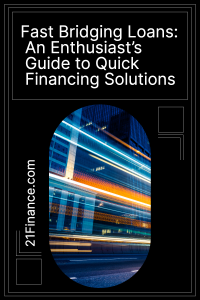Introduction to Bridging Loans
The world of finance is vast and can sometimes be overwhelming. When seeking a loan, speed and efficiency are paramount, especially for property deals. In the UK, fast bridging loans are the answer to these needs. As the name suggests, these loans bridge the gap between an urgent financial requirement and a more permanent financial solution becoming available.
The Concept of Fast Bridging Loans
Bridging loans are short-term funding solutions designed to cater to immediate financing needs. Typically, they are used to bridge the financial gap that can occur when you’re buying a property before selling your current one. They can also be used in other scenarios like renovating a property or funding a business venture.
The Need for Bridging Loans
Every property deal is unique and sometimes, traditional loans and mortgages just don’t cut it. Perhaps there’s a time constraint or maybe a particular property requires quick action to secure. Whatever the reason, bridging loans provide a lifeline, enabling deals to go through swiftly without the hassle of long approval times.
Advantages of Bridging Loans
Speed of Access
One of the main advantages of bridging loans is their speed. Traditional loans involve lengthy processes, including a detailed check of your credit history, income, and other financial obligations. This can take weeks or even months. Bridging loans, on the other hand, can be approved and the funds released within a few days or sometimes even within 24 hours!
Flexibility
Bridging loans are flexible. Unlike traditional loans that may be restrictive in their usage, bridging loans can be used for a variety of purposes. Whether it’s for a property auction purchase, renovation project, or business financing, a bridging loan can fit the bill.
Property Acquisition
Bridging loans have become an essential tool for property investors and developers. When conventional loans fail to meet the needs, bridging loans can step in to ensure that a great property deal isn’t lost.
How Fast Bridging Loans Work
Loan Application
Applying for a fast bridging loan is typically straightforward. Most lenders provide an online application form or a phone-based service. You’ll need to provide details about the property and your plans for repaying the loan.
Valuation of Property
The lender will then arrange for a professional valuation of your property. This is to assess the property’s worth and determine how much they can lend you. It’s essential to remember that the loan is secured against the property.
Loan Approval and Fund Release
Following a successful valuation, the lender will then review your proposed exit strategy. If satisfied, the loan is approved and the funds released.
Things to Consider Before Opting for a Fast Bridging Loan
Interest Rates
Fast bridging loans often come with higher interest rates compared to traditional loans. This is due to their short-term nature and the associated risks. Therefore, it’s vital to factor in these rates when considering a bridging loan.
Repayment Strategy
As with any loan, having a clear exit strategy is crucial. This is your plan for repaying the loan, typically through a long-term financial solution like a mortgage or the sale of a property.
Loan Terms
The terms and conditions for these type of loans can vary significantly among lenders. Always read and understand the fine print before signing on the dotted line.
Conclusion
Bridging loans offer a swift and effective solution to short-term property financing needs. While they offer numerous benefits, it’s essential to understand their costs and potential risks. As always, careful research and consideration should be at the forefront of your decision-making process.
FAQs
- How quickly can I access funds from a bridging loan? The speed varies but typically, you can access the funds within a few days of application approval. In some cases, it can be as quick as within 24 hours!
- Can I use it for something other than property-related purposes? Absolutely! While they are popular in the property market, they can also be used for other business or personal purposes.
- What’s the maximum amount I can borrow with a bridging loan? This depends on the value of your property and the lender’s assessment.
- What’s the typical interest rate? Interest rates can vary significantly, but they’re generally higher than traditional loans due to their short-term nature.
- What happens if I can’t repay my bridging loan? If you’re unable to repay the loan, the lender can repossess the property to recover their money. It’s, therefore, crucial to have a solid exit strategy in place.

